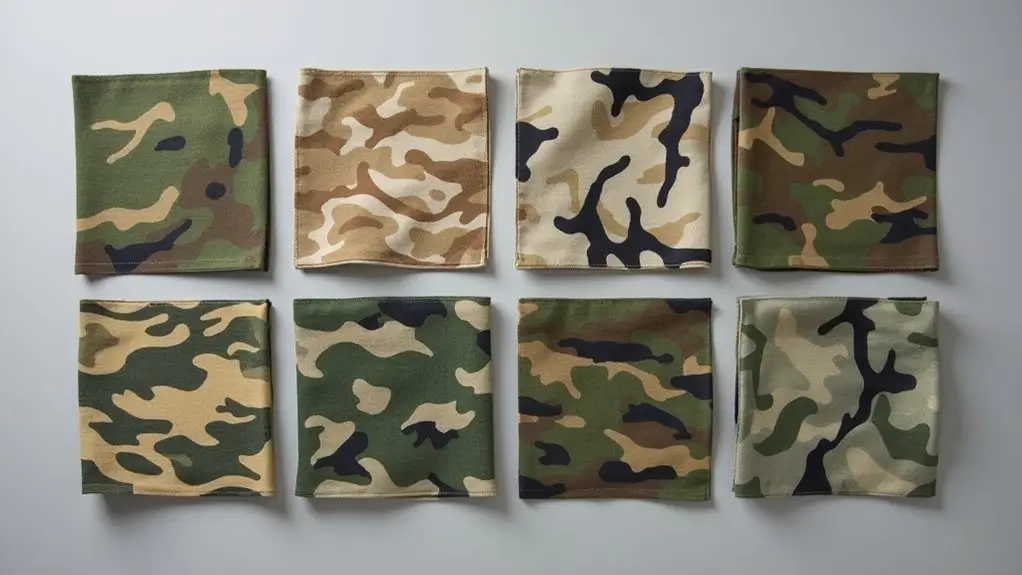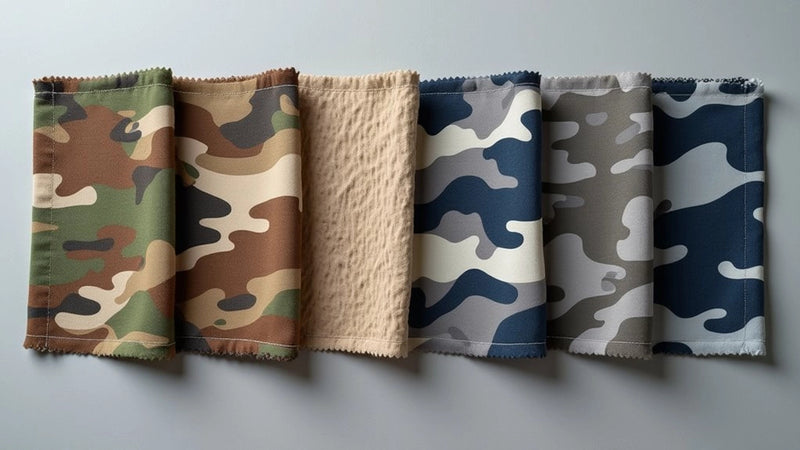You'll find that camouflage patterns serve distinct purposes beyond their aesthetic appeal. Whether you're planning a tactical operation, gearing up for hunting season, or exploring urban fashion trends, understanding the science and application of different camo designs can give you an essential advantage. From military-grade digital patterns to specialized hunting concealment and streetwear adaptations, each category offers unique benefits that align with specific environments and objectives. Let's examine the key distinctions that make each pattern effective.
Key Takeaways
- Military camouflage includes five main patterns: Woodland, Desert, Tiger Stripe, Digital, and MultiCam, each designed for specific environments.
- Hunting camo patterns use scientific research to match animal vision capabilities and incorporate natural elements like bark and leaves.
- Fashion camo adapts military and hunting patterns into urban, streetwear, and designer styles with non-traditional colors and bold designs.
- Digital camouflage uses pixelated squares of varying sizes to create geometric patterns that effectively disrupt visual outlines.
- Desert camouflage features tans, browns, and grays with macro and micro disruptions to match arid environments and sparse vegetation.
Types of Camo

You'll encounter three primary categories of camouflage patterns: military designs optimized for battlefield concealment, hunting patterns engineered for specific game and terrain, and fashion camo created purely for aesthetic appeal.
Military camo emphasizes tactical advantage through proven disruptive patterns.
Hunting camo focuses on breaking up your silhouette against specific natural environments and accounting for animal vision capabilities.
Fashion camo, though inspired by military and hunting designs, prioritizes style over concealment and often features bold, non-traditional colors and modifications.
Military Camo
Five primary military camouflage patterns have influenced modern hunting gear: Woodland, Desert, Tiger Stripe, Digital, and MultiCam. These operational camouflage designs represent the most common types of military camo available today.
- Woodland pattern uses irregular splotches of green, brown, and black.
- Desert pattern features tan and light brown patches for arid environments.
- Tiger Stripe combines vertical stripes with irregular shapes.
- Digital camo utilizes pixelated squares in varying sizes.
Modern camo patterns continue evolving through scientific research and field testing.
Understanding these foundational military designs helps you select the right pattern for your specific needs, whether for tactical operations or hunting applications.
Hunting Camo
Building upon military design principles, hunting camouflage has evolved into specialized patterns that address specific game animals, terrains, and seasons.
Modern hunting camo patterns incorporate scientific research on animal vision and natural concealment. You'll find designs that break up your silhouette using micro-patterns, while traditional types of camo feature realistic bark and leaf designs.
When choosing the right camouflage, consider your quarry and environment. For effective hunting, choose the best hunting camo pattern to your prey's visual capabilities, the terrain, and seasonal changes in vegetation.
Fashion Camo
While military and hunting applications drove early camouflage development, fashion designers have transformed these tactical patterns into mainstream style elements. Today's fashion camo utilizes modified versions of traditional patterns designed for both style and versatility.
- Urban Camo: Features high-contrast geometric patterns in non-traditional colors like pink, blue, or grayscale.
- Streetwear Camo: Incorporates oversized hunting camo patterns with bold color combinations.
- Designer Camo: Blends luxury elements with different types of camo, often mixing camouflage with brand logos.
- Vintage Military: Repurposes authentic military and hunting camo patterns in contemporary clothing cuts and fabrics.
This fusion of tactical utility and modern fashion has established camo as a permanent style staple.
Different Types of Camo Patterns

Modern camouflage patterns fall into five distinct categories that you'll encounter in hunting applications: natural patterns that mimic specific flora, geometric patterns that break up your silhouette, digital patterns incorporating pixelated designs for enhanced concealment, tree and leaf patterns optimized for woodland environments, and specialized waterfowl patterns engineered for marsh and wetland hunting.
Each pattern type serves a tactical purpose based on scientific research of animal vision and environmental conditions you'll face in the field. You'll need to match your pattern choice to your quarry's habitat, considering factors such as distance, lighting, and seasonal changes in vegetation.
Natural Patterns
Natural patterns in camouflage draw direct inspiration from five key environmental elements: bark textures, leaf configurations, grass structures, rock formations, and shadow effects.
These specialized patterns replicate nature's concealment strategies, drawing from animal camouflage techniques found in specific environments.
- Woodland camo mimics forest floor debris with overlapping leaf shapes.
- Bark-based patterns utilize vertical striping and rough textures.
- Prairie patterns incorporate grass blade structures and earth tones.
- Rock-inspired designs feature irregular shapes and natural shadows.
You'll find these natural elements most effective when matched to your hunting environment, as different patterns excel in varying terrains.
The key is selecting concealment that mirrors your surroundings' dominant features.
Geometric Patterns
Distinct from natural camouflage designs, geometric patterns represent a scientific evolution in concealment technology, utilizing calculated shapes and mathematical precision to break up the human form.
In modern hunting, digital camo leads this category with its pixelated appearance and macro patterns that effectively disrupt your outline at various distances.
You'll find these geometric patterns particularly effective in mixed terrain, where traditional designs might fall short.
While they may appear more vibrant in colors than conventional camo, their scientifically-engineered layouts often provide superior concealment.
When choosing the right camo pattern, consider that geometric designs work best in environments with diverse vegetation and multiple sight distances.
Digital Patterns
Building upon geometric innovations, digital camouflage patterns represent the latest advancement in concealment technology.
These pixelated designs combine micro-patterns and scientific research to maximize your hunting effectiveness.
- Digital camouflage utilizes computer-generated pixels that break up your outline more effectively than traditional military designs.
- Modern digital camo adapts to various light conditions and viewing distances.
- Different camouflage types feature precise pixel sizes optimized for specific hunting environments.
You'll find these advanced patterns particularly effective when hunting at longer ranges, where traditional patterns often fail to maintain their concealment properties.
Tree and Leaf Patterns
While digital patterns excel at longer ranges, tree and leaf patterns remain the cornerstone of traditional hunting camouflage by incorporating realistic foliage elements that match specific forest environments.
These natural camouflage designs feature intricate reproductions of bark textures, branches, and leaves native to specific types of terrain.
You'll find patterns combine multiple layers of forest elements, carefully designed to match seasonal considerations from early spring to late fall.
As a hunter, you'll benefit from tree and leaf patterns that mirror your exact hunting environment, whether it's oak woodlands, pine forests, or mixed hardwood areas.
Each camo pattern designed serves a distinct purpose in various lighting conditions.
Waterfowl Patterns
Waterfowl hunting demands specialized camouflage patterns that adapt to wetland environments and skyline concealment.
You'll need specific camo patterns designed for marsh and wetland terrain to enhance your hunting success.
These patterns help you maintain effective concealment while hunting from blinds or layout boats.
Desert Camo Patterns
Desert camouflage patterns utilize specialized color schemes and disruptive designs to help hunters and tactical operators blend into arid environments.
Modern desert camo uses technology to incorporate tans, browns, and grays that match sun-bleached rocks and sparse vegetation. The universal camouflage pattern, while controversial in military use, has influenced various types of hunting camo for desert regions.
You'll find that effective desert patterns feature macro and micro disruption elements to break up your silhouette at different distances.
Colors designed for these patterns typically include khaki, coyote brown, and light sage, helping you maintain concealment during both dawn and dusk hunting conditions.
Frequently Asked Questions
How Do I Maintain and Clean My Camouflage Clothing Without Damaging the Pattern?
You'll need to wash your camo in cold water with unscented detergent, avoid bleach or fabric softeners, and air dry. Don't machine dry, as heat can fade patterns and damage moisture-wicking properties.
Can Colorblind Hunters Effectively Use Modern Camouflage Patterns?
Yes, you'll be effective with modern camo since they're designed for pattern disruption, not color matching. Your colorblindness won't impact hunting as most prey animals rely on movement detection and pattern recognition.
Do Scent-Blocking Treatments Affect the Effectiveness of Camouflage Patterns?
No, scent-blocking treatments won't compromise your camo pattern's effectiveness. These treatments are applied during manufacturing to work at a molecular level, preserving the visual properties while reducing your scent signature.
Conclusion
Selecting ideal camouflage requires precise analysis of your operational environment and mission parameters. You'll need to evaluate terrain composition, seasonal variations, and engagement distances. Whether you're deploying military-grade patterns, utilizing hunting-specific designs, or incorporating tactical elements into urban wear, your choice must align with both concealment objectives and practical functionality. Remember: effective camouflage isn't just about pattern selection—it's about strategic implementation across your entire loadout.


0 comments